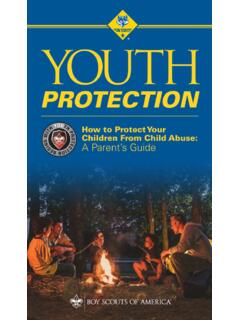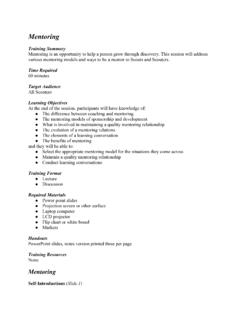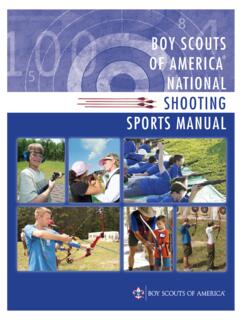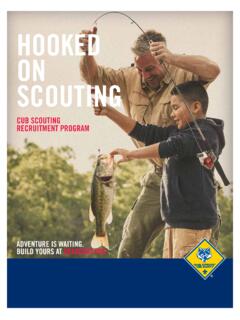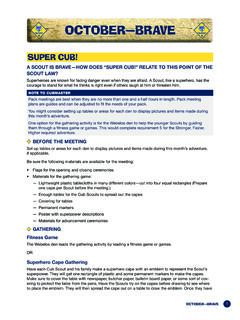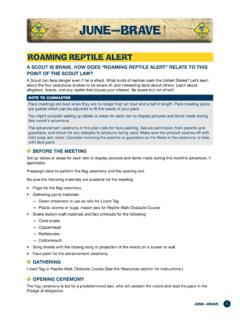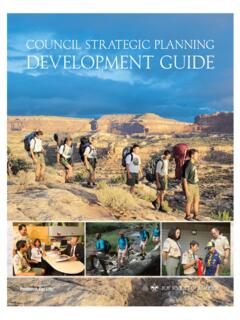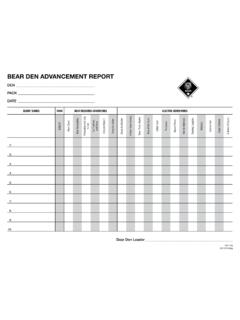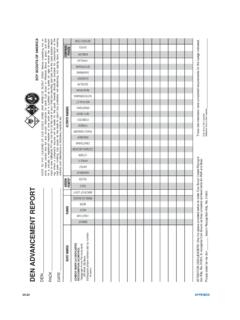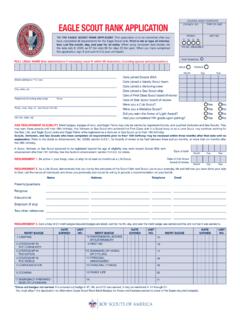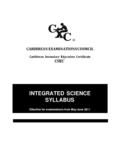Transcription of Scoutmaster Position-Specific Training
1 Scoutmaster Position-Specific Training1 Scoutmaster Position-Specific TrainingCONTENTS Organizing and Delivering the Course ..2 Gathering Activity ..10 Opening and Introductions ..12 Aims and Methods of Scouting ..14 Role of the Patrol Method ..20 The Troop Meeting ..26 Advancement ..31 The Support Team ..35 Annual Planning ..40 Wrap-Up ..46 Appendix A: Equipment and Materials ..47 Appendix B: Samples of Course Posters ..48 Appendix C: Aims of Scouting ..50 Appendix D: Organization of Boy Scouting ..51 Appendix E: What Makes a Trained Leader? ..52 Appendix F: Age-Appropriate Guidelines for Scouting Activities ..53 Appendix G: The Scoutmaster Conference ..55 Appendix H: Sample Scoutmaster Conference Questions ..60 Appendix I: Advancement Checklists ..62 Appendix J: Advancement Simulation Cards ..63 Appendix K: Participant Course Assessment ..722 Scoutmaster Position-Specific TrainingOrganizing and Delivering the Course: Notes for the Training TeamWhy Training ?
2 To do anything well, people need Training , in whatever form that takes. Training may be formal or informal; it may help someone learn to ride a bicycle, drive a car, or perform better at a job. Training can be conducted in a group setting or individually. In the end, the result of high-quality Training is a person s ability to do something new or better, and a feeling of satisfaction from the effectively the Boy Scouts of America influences the lives of youth depends on its leaders and their ability to apply the aims and methods of Scouting these are the keys, and developing the ability to use these keys is what this course is all Position-Specific Training , course code S24, is the BSA s initial level of Training for the top leaders of Boy Scout troops. It is designed for Scoutmasters, assistant Scoutmasters, and junior assistant Scoutmasters. However, committee members and other adults connected to a Boy Scout troop are welcome to Scoutmaster Position-Specific Training and Introduction to Outdoor Leader Skills (IOLS) have both been completed, new Scoutmasters will have the tools needed to begin an effective Boy Scouting to Use This SyllabusThroughout the syllabus , trainers will find notes to the instructor that incorporate important points to help deliver quality Training .
3 The following icons are used throughout to bring attention to key points, best practices, and potential pitfalls:SparkThis icon highlights important points for the instructor to ToolThis icon signals an expanded explanation that may help trainers and participants better understand the point being to AvoidThis cautionary note will help the instructor stay within the intent of the lesson and avoid tangential discussions. It may be better to conduct these discussions during a break or in a different Position-Specific Training is intentionally designed as a half-day course in order to respect the time of busy Scoutmasters, and where possible, it may be offered in conjunction with IOLS. Scoutmaster Position-Specific Training cannot provide adult leaders everything they need to know to be successful Scoutmasters. The unit commissioner, the Troop Leader Guidebook, the Boy Scout Handbook, and supplemental Training will fill in most of the Position-Specific TrainingThe burden is on the Training team to ensure the participants perceive this initial Training as effective, useful, and fun.
4 This Training experience should leave the Scoutmasters who attend enthusiastic about participating in additional district, council, regional, and national Training opportunities as they continue in the specified, this syllabus is not intended to be read content notes in the individual lessons are, in most cases, written to help the trainers develop their presentations. Trainers should be familiar with the content and be able to present it without reading. Experienced trainers should use their own words, but they must make sure to cover the content and meet the objectives of the of the keys to success is for trainers to observe the participants during the sessions especially during the hands-on phases to be sure they are engaged and have learned the topic before moving are no PowerPoint slides provided. It is recommended that the Training team use a variety of teaching methods to achieve the desired learning paraphrase a famous Walt Disney quote, Scoutmaster Position-Specific Training should be so much fun and so valuable that participants want to come back and bring their Protection Training is a joining requirement for all registered adult leaders in the Boy Scouts of America.
5 Therefore, it is assumed that every adult attending this course has completed Youth Protection Training . If this is not the case, the individual should complete Youth Protection Training as soon as possible. Be sure to check with each participant attending the course; if any are missing Youth Protection Training , help them locate a convenient opportunity to take the Training as soon as share with participants, preferably before the course, that Boy Scout Leader Fast Start Training is a short online course that provides some basic knowledge and an introduction to Boy Scouting terminology. Fast Start offers new leaders a starting point, and Scoutmaster Position-Specific Training builds upon that foundation. Fast Start is not a requirement for becoming a trained leader (see What Makes a Trained Leader? Appendix E), but new leaders will find it to be an excellent introduction to Scouting, and they should be encouraged to review it before taking this course. Youth Protection Training and Fast Start may be found at Position-Specific TrainingCourse ObjectivesThe purpose of Scoutmaster Position-Specific Training is to provide an active, fun, and positive learning experience for new and experienced Scoutmasters to learn and apply proven techniques for running an effective Boy Scout troop.
6 Scoutmasters will learn how to meet the aims of Scouting by applying the eight methods of the Boy Scouting program during the four main sessions of the course: Patrol Method Support Team Advancement Annual PlanningReferencesScoutmasters will need to be familiar with the publications noted below. These references were also used to create this course. Course faculty should highlight and show the relevant BSA literature used during each and council Training teams should consider having copies of the Troop Leader Guidebook and the Boy Scout Handbook available for purchase prior to the Training . It will be necessary to have excerpts from Program Features for Troops, Teams, and Crews, Troop Program Resources, and the Guide to Safe Scouting available for use during group work or as handouts. Troop Leader Guidebook Boy Scout Handbook Program Features for Troops, Teams and Crews, Volumes 1, 2, and 3 (available at Scout shops, at , or in a Kindle version at ) Guide to Safe Scouting (available as a PDF at ) Troop Program Resources (available from your council Scout shop or ) Senior Patrol Leader Handbook Patrol Leader Handbook Guide to Advancement (available as a PDF at ) Posters, Aims of Boy Scouting and Methods of Boy Scouting (Appendix B)Ensure the participants know to bring their copies of the Troop Leader Guidebook and Boy Scout Handbook, as they will need to refer to these publications during the great BSA publications, such as Trek Safely and Safe Swim Defense, should be reserved for future supplemental Training opportunities.
7 Scouting magazine is another resource for staying abreast of program ideas. There are also useful newsletters and forums available on It may be appropriate to have samples of these pamphlets, magazines, publications, and newsletters displayed on a side table in order to generate interest in future learning and program opportunities. It is also helpful to provide participants a handout or flier listing upcoming council and district program and Training Position-Specific TrainingTimeScoutmaster Position-Specific Training should take about 41/2 hours. The sessions are intentionally short: They introduce the subjects and show the participants how to use the BSA literature. Specific questions should be addressed to the troop guides during breaks and during follow-up coaching sessions with the troop s unit teams are urged to conduct a faculty development session prior to offering this Training in order to facilitate timing of presentations and to avoid faculty outstanding opportunity to explore these topics in detail is through supplemental Training provided by the district or council.
8 Supplemental Training allows experienced unit leaders to share the lessons they have learned with new Scoutmasters. The council may utilize roundtables and other supplemental Training opportunities to delve into additional topics in sample schedule for this Training might look like this:StartEndTitleInstructorRemarks8 :30 Activity (during registration)8:30 :45 and Introductions8:45 and Methods9 :20 of the Scoutmaster9:20 :55 Patrol Method9:55 :05 :05 :35 Troop Meeting10:35 :55 :55 :15 Support Team11:15 :30 :30 :10 Planning12:10 :20 :20 :30 :30 Reflection (no participants)Clean up facility (no participants)Faculty UniformsThe course faculty members should set a good example as trainers and representatives of the local council. Accordingly, they are expected to wear the complete and correct Scouting field uniform appropriate to their Scouting positions during the the Class: Modeling the Patrol MethodThe course is intended to be taught in small groups of five to six participants in order to model and demonstrate the patrol method, the BSA s essential, small-group, peer-learning method.
9 At times during the course, a faculty member will act as a facilitator for each patrol, modeling the role of a troop guide, with one facilitator for each group of five or six participants. Therefore, the class size will dictate the number of faculty members needed to run the course. The Training 6 Scoutmaster Position-Specific Trainingis intended to be conducted with the minimum amount of lecture. Boys and adults stay with Scouting when their patrols and troops are active in the outdoors, during meetings, and when learning. The learning in this course models the feeling boys get when they belong to a patrol, and the course reinforces the patrol method by example. Even Training sessions that have a small number of participants should still try, as much as possible, to model the patrol method. Consideration should be given to using smaller groups of three or four Scouters in order to re-create the sense of optimum facility will be arranged to accommodate the patrol model.
10 Auditorium-style seating is nearly always the least effective classroom arrangement for a course such as Scoutmaster Position-Specific Training as it inhibits student interaction, social bonding, and the shared reinforcement that is the hallmark of the patrol method. Training outside is almost always the best location!It is recommended to use a classroom (or picnic table) seating style that encourages collaboration and sharing among the participants, such as the one shown below, which allows all participants to see the instructor as well as collaborate among the members of the small group:Be sure to consider any requirements for special access to facilitate participation by Scouters with unique should be sufficient open space readily available for the participants to conduct the group activities. Be cognizant of the weather and Be Prepared. Faculty DevelopmentThe Training team serves as an important recruiting and retention tool for the district and council. The ability of Training teams to deliver effective Training programs has proven to have a direct and measurable impact on the success of development is an ongoing process designed to ensure the quality, consistency, and effectiveness of the council s learning programs.
